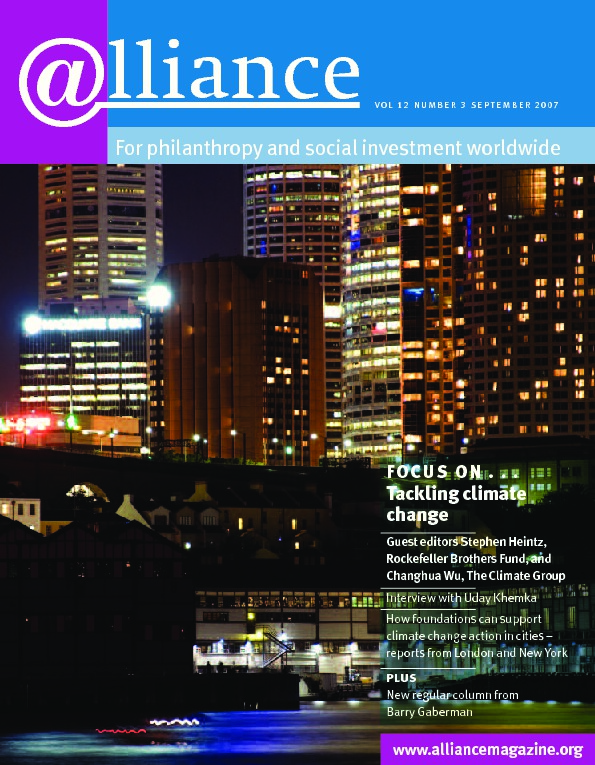If we are to succeed in tackling global warming, one of the first questions climate policymakers must consider is where to place the cap on carbon. An ‘upstream’ or ‘economy-wide’ cap, as advocated in this article, has many advantages. Stimulating a wide-ranging debate on the subject and supporting citizens groups who are advocating new solutions is a key role to be played by the philanthropic community.
Because the first nationwide cap-and-trade system, on sulphur emissions, put caps at the chimneys of coal-burning power plants, policymakers tend to think of cap-and-trade systems only in those terms. That is a bad habit. Though chimneys are the logical place to cap sulphur emissions, they are not the best place to cap carbon emissions.
Carbon dioxide is not an impurity that can be removed from an effluent pipe; it’s an unavoidable byproduct of the stuff we burn to power our economy. Moreover, it doesn’t just trickle from a few large plants; it gushes from millions of tailpipes and flues. Trying to monitor and reduce carbon dioxide as it leaves all these pipes is impossible.
There’s a better place to cap carbon: at the relatively few points where it enters the economy. To make a crude but useful analogy, think of carbon as flowing through our economy the way water flows through a garden hose. To reduce the flow of water, you wouldn’t plug holes in the sprinkler, you’d turn down the tap. If we want to reduce the flow of carbon, the easiest way is to turn a valve at the top of the economy.
The valve would work like this. All companies that bring burnable carbon into the economy – coal mines, oil or gas wells, tankers, pipelines or biofuel refineries – would be required to buy permits for the carbon content of their fuels. Each year the number of permits would be reduced, which would reduce the amount of carbon flowing through the economy and ultimately into the atmosphere. To cut carbon emissions by 80 per cent in 40 years, we need to reduce the number of permits by an average of 2 per cent per year.
Economists call this an ‘upstream’ or ‘economy-wide’ cap. It would be easy to administer because there are only a few hundred companies that bring carbon into the US. During the course of a year these companies would have to own permits equal to the carbon content of the fuels they bring in. Once a year they’d account to the government and pay a penalty if they didn’t own enough permits.
Ease of administration isn’t the only advantage of an upstream cap. Its chief virtue is that it would cap all the carbon in the economy. Whether carbon is ultimately burned in power plants, vehicles or buildings, it would need a permit to get there, and those permits would become increasingly scarce and costly.
Of course, though only upstream companies would need permits, everyone would feel the effect of an upstream cap through higher fuel prices, and rising prices would spur private investment in conservation, efficiency and renewables. It’s also worth noting that, though a descending upstream cap is the single best macroeconomic tool for reducing carbon emissions, it should be accompanied by other policies that offset the regressive impact and political unpopularity of higher fuel prices and accelerate the transition to a low-carbon economy.
Thus, the ideal policy suite would start with permits that are sold to companies at the top of the carbon chain. The revenue from permit sales would then be divided between per capita rebates to consumers and investment in public goods such as mass transit, an upgraded electric grid, and clean energy R&D. Sectoral policies that spur the regulated sectors to cut carbon use could also be added, but the descending upstream cap would drive all sectors of the economy toward the aggregate emissions goal, regardless of how well these regulatory policies work.
However promising the upstream cap idea may seem, we need to be open to a range of solutions. Many states are designing ‘cap-and-trade’ systems, and Congress is considering them as well. It is here that the opportunities for philanthropy arise. Donors should look for citizens’ groups (such as the Union of Concerned Scientists and the US Public Interest Research Groups) that are participating in these debates, and for academics (such as Yale’s Robert Repetto and the University of Vermont’s Robert Costanza) who are advocating upstream caps. My own organization, the Tomales Bay Institute, is actively engaged in advocating upstream caps, permit auctions, and rebates to individuals in order to mitigate the impact of higher carbon prices.
Peter Barnes is a senior fellow at the Tomales Bay Institute in northern California. Email peter@tomales.org






Comments (0)